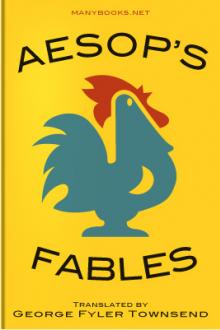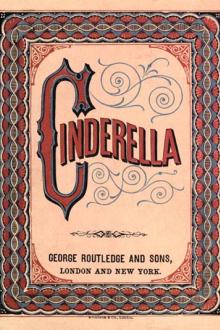Aesop's Fables by Aesop (best ebook reader for ubuntu txt) 📕

The Fox and the Goat
A FOX one day fell into a deep well and could find no means of escape. A Goat, overcome with thirst, came to the same well, and seeing the Fox, inquired if the water was good. Concealing his sad plight under a merry guise, the Fox indulged in a lavish praise of the water, saying it was excellent beyond measure, and encouraging him to descend. The Goat, mindful only of his thirst, thoughtlessly jumped down, but just as he drank, the Fox informed him of the difficulty they were both in and suggested a scheme for their common escape. "If," said he, "you will place your forefeet upon the wall and bend your head, I will run up your back and escape, and will help you out afterwards." The Goat readily assented and the Fox leaped upon his back. Steadying himself with the Goat's horns, he safely reached the mouth of the well and made off as fast as he could. When the Goat upbraided him for breaking his promise, he turned around and cried out, "You foolish old fellow! If
Read free book «Aesop's Fables by Aesop (best ebook reader for ubuntu txt) 📕» - read online or download for free at americanlibrarybooks.com
- Author: Aesop
- Performer: 0877017808
Read book online «Aesop's Fables by Aesop (best ebook reader for ubuntu txt) 📕». Author - Aesop
On the invitation of Croesus he fixed his residence at Sardis, and was employed by that monarch in various difficult and delicate affairs of State. In his discharge of these commissions he visited the different petty republics of Greece. At one time he is found in Corinth, and at another in Athens, endeavouring, by the narration of some of his wise fables, to reconcile the inhabitants of those cities to the administration of their respective rulers Periander and Pisistratus. One of these ambassadorial missions, undertaken at the command of Croesus, was the occasion of his death. Having been sent to Delphi with a large sum of gold for distribution among the citizens, he was so provoked at their covetousness that he refused to divide the money, and sent it back to his master. The Delphians, enraged at this treatment, accused him of impiety, and, in spite of his sacred character as ambassador, executed him as a public criminal. This cruel death of Aesop was not unavenged. The citizens of Delphi were visited with a series of calamities, until they made a public reparation of their crime; and, “The blood of Aesop” became a well-known adage, bearing witness to the truth that deeds of wrong would not pass unpunished. Neither did the great fabulist lack posthumous honors; for a statue was erected to his memory at Athens, the work of Lysippus, one of the most famous of Greek sculptors. Phaedrus thus immortalizes the event:
Aesopo ingentem statuam posuere Attici, Servumque collocarunt aeterna in basi: Patere honoris scirent ut cuncti viam; Nec generi tribui sed virtuti gloriam.
These few facts are all that can be relied on with any degree of certainty, in reference to the birth, life, and death of Aesop. They were first brought to light, after a patient search and diligent perusal of ancient authors, by a Frenchman, M. Claude Gaspard Bachet de Mezeriac, who declined the honor of being tutor to Louis XIII of France, from his desire to devote himself exclusively to literature. He published his Life of Aesop, Anno Domini 1632. The later investigations of a host of English and German scholars have added very little to the facts given by M. Mezeriac. The substantial truth of his statements has been confirmed by later criticism and inquiry. It remains to state, that prior to this publication of M. Mezeriac, the life of Aesop was from the pen of Maximus Planudes, a monk of Constantinople, who was sent on an embassy to Venice by the Byzantine Emperor Andronicus the elder, and who wrote in the early part of the fourteenth century. His life was prefixed to all the early editions of these fables, and was republished as late as 1727 by Archdeacon Croxall as the introduction to his edition of Aesop. This life by Planudes contains, however, so small an amount of truth, and is so full of absurd pictures of the grotesque deformity of Aesop, of wondrous apocryphal stories, of lying legends, and gross anachronisms, that it is now universally condemned as false, puerile, and unauthentic. l It is given up in the present day, by general consent, as unworthy of the slightest credit. G.F.T.
1 M. Bayle thus characterises this Life of Aesop by Planudes, “Tous les habiles gens conviennent que c’est un roman, et que les absurdites grossieres qui l’on y trouve le rendent indigne de toute.” Dictionnaire Historique. Art. Esope. *********Preface******** PREFACE
THE TALE, the Parable, and the Fable are all common and popular modes of conveying instruction. Each is distinguished by its own special characteristics. The Tale consists simply in the narration of a story either founded on facts, or created solely by the imagination, and not necessarily associated with the teaching of any moral lesson. The Parable is the designed use of language purposely intended to convey a hidden and secret meaning other than that contained in the words themselves; and which may or may not bear a special reference to the hearer, or reader. The Fable partly agrees with, and partly differs from both of these. It will contain, like the Tale, a short but real narrative; it will seek, like the Parable, to convey a hidden meaning, and that not so much by the use of language, as by the skilful introduction of fictitious characters; and yet unlike to either Tale or Parable, it will ever keep in view, as its high prerogative, and inseparable attribute, the great purpose of instruction, and will necessarily seek to inculcate some moral maxim, social duty, or political truth. The true Fable, if it rise to its high requirements, ever aims at one great end and purpose representation of human motive, and the improvement of human conduct, and yet it so conceals its design under the disguise of fictitious characters, by clothing with speech the animals of the field, the birds of the air, the trees of the wood, or the beasts of the forest, that the reader shall receive advice without perceiving the presence of the adviser. Thus the superiority of the counsellor, which often renders counsel unpalatable, is kept out of view, and the lesson comes with the greater acceptance when the reader is led, unconsciously to himself, to have his sympathies enlisted in behalf of what is pure, honorable, and praiseworthy, and to have his indignation excited against what is low, ignoble, and unworthy. The true fabulist, therefore, discharges a most important function. He is neither a narrator, nor an allegorist. He is a great teacher, a corrector of morals, a censor of vice, and a commender of virtue. In this consists the superiority of the Fable over the Tale or the Parable. The fabulist is to create a laugh, but yet, under a merry guise, to convey instruction. Phaedrus, the great imitator of Aesop, plainly indicates this double purpose to be the true office of the writer of fables.
Duplex libelli dos est: quod risum movet, Et quod prudenti vitam consilio monet.
The continual observance of this twofold aim creates the charm, and accounts for the universal favor, of the fables of Aesop. “The fable,” says Professor K. O. Mueller, “originated in Greece in an intentional travestie of human affairs. The ‘ainos,’ as its name denotes, is an admonition, or rather a reproof veiled, either from fear of an excess of frankness, or from a love of fun and jest, beneath the fiction of an occurrence happening among beasts; and wherever we have any ancient and authentic account of the Aesopian fables, we find it to be the same.” l
The construction of a fable involves a minute attention to (1) the narration itself; (2) the deduction of the moral; and (3) a careful maintenance of the individual characteristics of the fictitious personages introduced into it. The narration should relate to one simple action, consistent with itself, and neither be overladen with a multiplicity of details, nor distracted by a variety of circumstances. The moral or lesson should be so plain, and so intimately interwoven with, and so necessarily dependent on, the narration, that every reader should be compelled to give to it the same undeniable interpretation. The introduction of the animals or fictitious characters should be marked with an unexceptionable care and attention to their natural attributes, and to the qualities attributed to them by universal popular consent. The Fox should be always cunning, the Hare timid, the Lion bold, the Wolf cruel, the Bull strong, the Horse proud, and the Ass patient. Many of these fables are characterized by the strictest observance of these rules. They are occupied with one short narrative, from which the moral naturally flows, and with which it is intimately associated. “‘Tis the simple manner,” says Dodsley, 2 “in which the morals of Aesop are interwoven with his fables that distinguishes him, and gives him the preference over all other mythologists. His ‘Mountain delivered of a Mouse,’ produces the moral of his fable in ridicule of pompous pretenders; and his Crow, when she drops her cheese, lets fall, as it were by accident, the strongest admonition against the power of flattery. There is no need of a separate sentence to explain it; no possibility of impressing it deeper, by that load we too often see of accumulated reflections.” 3 An equal amount of praise is due for the consistency with which the characters of the animals, fictitiously introduced, are marked. While they are made to depict the motives and passions of men, they retain, in an eminent degree, their own special features of craft or counsel, of cowardice or courage, of generosity or rapacity.
These terms of praise, it must be confessed, cannot be bestowed on all the fables in this collection. Many of them lack that unity of design, that close connection of the moral with the narrative, that wise choice in the introduction of the animals, which constitute the charm and excellency of true Aesopian fable. This inferiority of some to others is sufficiently accounted for in the history of the origin and descent of these fables. The great bulk of them are not the immediate work of Aesop. Many are obtained from ancient authors prior to the time in which he lived. Thus, the fable of the “Hawk and the Nightingale” is related by Hesiod; 4 the “Eagle wounded by an Arrow, winged with its own Feathers,” by Aeschylus; 5 the “Fox avenging his wrongs on the Eagle,” by Archilochus. 6 Many of them again are of later origin, and are to be traced to the monks of the middle ages: and yet this collection, though thus made up of fables both earlier and later than the era of Aesop, rightfully bears his name, because he composed so large a number (all framed in the same mould, and conformed to the same fashion, and stamped with the same lineaments, image, and superscription) as to secure to himself the right to be considered the father of Greek fables, and the founder of this class of writing, which has ever since borne his name, and has secured for him, through all succeeding ages, the position of the first of moralists.7
The fables were in the first instance only narrated by Aesop, and for a long time were handed down by the uncertain channel of oral tradition. Socrates is mentioned by Plato 8 as having employed his time while in prison, awaiting the return of the sacred ship from Delphos which was to be the signal of his death, in turning some of these fables into verse, but he thus versified only such as he remembered. Demetrius Phalereus, a philosopher at Athens about 300 B.C., is said to have made the first collection of these fables. Phaedrus, a slave by birth or by subsequent misfortunes, and admitted by Augustus to the honors of a freedman, imitated many of these fables in Latin iambics about the commencement of the Christian era. Aphthonius, a rhetorician of





Comments (0)